|
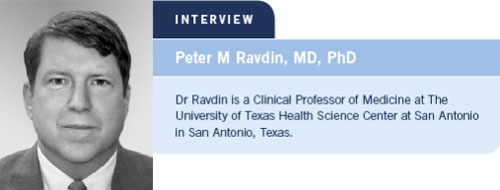
| Tracks 1-18 |
| Track 1 |
Introduction by Neil Love, MD |
| Track 2 |
Incorporating adjuvant
trastuzumab into
clinical practice |
| Track 3 |
Impact of adjuvant trastuzumab
on relapse and survival |
| Track 4 |
Clinical implications of the
adjuvant trastuzumab data |
| Track 5 |
NSABP-B-31 and NCCTGN9831:
Effect of trastuzumab
on cardiac function |
| Track 6 |
Concurrent versus sequential
adjuvant trastuzumab with
chemotherapy |
| Track 7 |
Duration and timing of adjuvant
trastuzumab therapy |
| Track 8 |
Monitoring cardiac function
in patients receiving adjuvant
trastuzumab |
| Track 9 |
Impact of targeted therapy on
breast cancer mortality |
| Track 10 |
Canadian study validating the
Adjuvant! online computer
model |
|
| Track 11 |
Overview of the adjuvant trials of
aromatase inhibitors |
| Track 12 |
Five years of adjuvant tamoxifen
versus switching to an aromatase
inhibitor |
| Track 13 |
Duration of aromatase inhibitor
therapy following adjuvant
tamoxifen |
| Track 14 |
Adjuvant hormonal therapy for
premenopausal patients with
ER-positive, HER2-positive
disease |
| Track 15 |
Efficacy of chemotherapy in
patients with ER-positive
versus ER-negative disease |
| Track 16 |
TAC versus FEC in patients
with ER-positive breast cancer |
| Track 17 |
EBCTCG meta-analysis of
chemotherapy and hormonal
therapy in early breast cancer |
| Track 18 |
Impact of adjuvant therapy on
micrometastatic disease |
|
|
Select Excerpts from the Interview*
 Track 2 Track 2
 DR LOVE: Your Adjuvant! Online model provides important estimates on
the projected benefits of adjuvant therapy. How are you going to include
trastuzumab in the model? DR LOVE: Your Adjuvant! Online model provides important estimates on
the projected benefits of adjuvant therapy. How are you going to include
trastuzumab in the model? |
 DR RAVDIN: There really are three questions that need to be addressed to
incorporate this data. The first question is, what are the real efficacy numbers? DR RAVDIN: There really are three questions that need to be addressed to
incorporate this data. The first question is, what are the real efficacy numbers?
What we’ve seen in the combined analysis of the North American data, as
projected for three years of follow-up, is a proportional risk reduction of about
53 percent for relapse and about 33 percent for death for those patients who
received trastuzumab (Romond 2005; [2.1]). I believe those numbers are still
probably unstable in terms of the fact that they represent the impact of the
very earliest relapses.
The second question is, how should we use this information? It potentially
will impact how the model is used not only for patients with HER2-positive
disease but also those with HER2-negative disease. The estimates in the
population with HER2-negative disease will have modestly better risk than if
it had included the patients with HER2-positive disease.
The third question addresses the toxicity aspect of trastuzumab therapy, that
is, how safe is the therapy over a long period of time? We have three years of
data at this point, so whether there’s any late cardiac toxicity from the therapy
has not been thoroughly addressed. The initial part of the data looks hopeful
because most of the toxicity occurs during therapy.
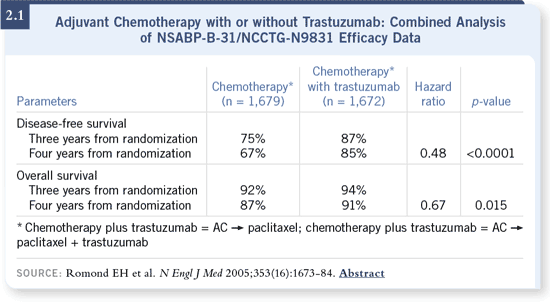
 Track 4 Track 4
 DR LOVE: Do you believe that trastuzumab should now be offered and
utilized in the adjuvant setting? DR LOVE: Do you believe that trastuzumab should now be offered and
utilized in the adjuvant setting? |
 DR RAVDIN: With three trials showing consistent effects, trastuzumab is ready
to be used in the adjuvant setting. All of the trials show great consistency.
Although the Intergroup and the NSABP trials were combined for analysis
(2.1), they were also split out in the presentations so you could see the effects
in each one of the trials, and the results were virtually identical (Romond
2005; [2.2]). DR RAVDIN: With three trials showing consistent effects, trastuzumab is ready
to be used in the adjuvant setting. All of the trials show great consistency.
Although the Intergroup and the NSABP trials were combined for analysis
(2.1), they were also split out in the presentations so you could see the effects
in each one of the trials, and the results were virtually identical (Romond
2005; [2.2]).
The data from the European study — although trastuzumab was administered
in a slightly different way — were consistent with trastuzumab having
powerful adjuvant effects (Piccart-Gebhart 2005). So I believe we have as
good evidence for the early effectiveness of trastuzumab as we have for any
other agent right now in breast cancer.
 DR LOVE: What about the use of adjuvant trastuzumab in patients with node-negative
disease? DR LOVE: What about the use of adjuvant trastuzumab in patients with node-negative
disease?
 DR RAVDIN: The issues for determining when to use trastuzumab are going
to be the same as those faced when deciding to use chemotherapy or hormonal
therapy. They are going to be a balance between benefit and risk. We have a
spectacular early benefit; however, we still need much more information about
risks. It’s the patients with Stage I node-negative disease for whom it’s quite
possible that the benefit-to-risk ratio will not actually point favorably in the
direction of the use of trastuzumab. DR RAVDIN: The issues for determining when to use trastuzumab are going
to be the same as those faced when deciding to use chemotherapy or hormonal
therapy. They are going to be a balance between benefit and risk. We have a
spectacular early benefit; however, we still need much more information about
risks. It’s the patients with Stage I node-negative disease for whom it’s quite
possible that the benefit-to-risk ratio will not actually point favorably in the
direction of the use of trastuzumab.
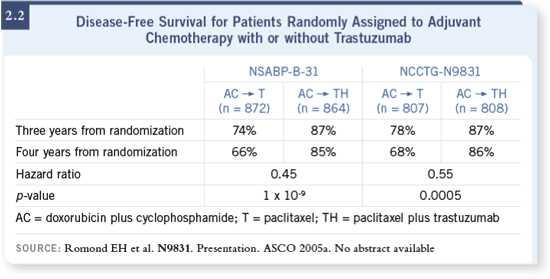
 Track 5 Track 5
 DR LOVE: What information do we now have regarding cardiac function
and trastuzumab? DR LOVE: What information do we now have regarding cardiac function
and trastuzumab? |
 DR RAVDIN: In the analysis of the NSABP-B-31 trial, the cumulative hazard
of developing congestive heart failure was four percent at three years of follow-up.
Most of that four percent occurred within the year of trastuzumab treatment.
There were some that occurred afterwards; however, it didn’t appear to
be accelerating (Romond 2005; [2.3]). DR RAVDIN: In the analysis of the NSABP-B-31 trial, the cumulative hazard
of developing congestive heart failure was four percent at three years of follow-up.
Most of that four percent occurred within the year of trastuzumab treatment.
There were some that occurred afterwards; however, it didn’t appear to
be accelerating (Romond 2005; [2.3]).
What we know from anthracycline-based regimens is that they cause an excess
incidence of congestive heart failure of somewhere around 0.5 to one percent.
I wouldn’t be surprised if trastuzumab doubled that to a level of maybe one to
two percent.
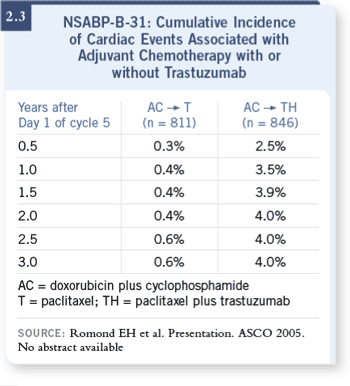 If that’s the case, then there may be some patients for whom that risk will
outweigh the potential benefits. Although it is also important to note that in
the Intergroup and NSABP
trials with over 3,000
patients, there has been only
one cardiac death so far,
which was in the control arm
(Romond 2005b). If that’s the case, then there may be some patients for whom that risk will
outweigh the potential benefits. Although it is also important to note that in
the Intergroup and NSABP
trials with over 3,000
patients, there has been only
one cardiac death so far,
which was in the control arm
(Romond 2005b).
 Track 6 Track 6
 DR LOVE: In your own
practice, will you start
trastuzumab during the
taxane portion of chemotherapy
or wait until
the chemotherapy is
completed? DR LOVE: In your own
practice, will you start
trastuzumab during the
taxane portion of chemotherapy
or wait until
the chemotherapy is
completed? |
 DR RAVDIN: I will be
starting trastuzumab
concurrently with paclitaxel.
There really are two pieces of information that address this issue, and
they’re somewhat contradictory. One of them is in the Intergroup study. It
had an arm that was not included in the NSABP-B-31 study — a sequential
arm — in which all of the
chemotherapy was administered
before trastuzumab was
started (Romond 2005a). In
this arm, the proportional
risk reduction was a lot less
obvious and spectacular than
with concurrent treatment. DR RAVDIN: I will be
starting trastuzumab
concurrently with paclitaxel.
There really are two pieces of information that address this issue, and
they’re somewhat contradictory. One of them is in the Intergroup study. It
had an arm that was not included in the NSABP-B-31 study — a sequential
arm — in which all of the
chemotherapy was administered
before trastuzumab was
started (Romond 2005a). In
this arm, the proportional
risk reduction was a lot less
obvious and spectacular than
with concurrent treatment.
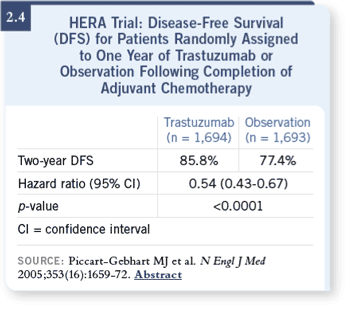 The European data actually
point in a somewhat opposite
direction. The patients in
the European trial completed
their chemotherapy before
trastuzumab was started, and
those patients seemed to
gain more than a 40 percent
proportional benefit (Piccart-
Gebhart 2005; [2.4]). In that case, administering chemotherapy and trastuzumab
sequentially seemed to work quite well.
The European data actually
point in a somewhat opposite
direction. The patients in
the European trial completed
their chemotherapy before
trastuzumab was started, and
those patients seemed to
gain more than a 40 percent
proportional benefit (Piccart-
Gebhart 2005; [2.4]). In that case, administering chemotherapy and trastuzumab
sequentially seemed to work quite well.
At any rate, there didn’t seem to be any additional risks to administering them
concurrently, at least with the safety data we have now. The benefit certainly
looked a little bit better — actually, a lot better — in the Intergroup study
(Perez 2005). I believe most people will be starting trastuzumab at the same
time they’re starting paclitaxel.
 Track 7 Track 7
 DR LOVE: At this point, all of the trastuzumab data are for a total
duration of one year. Is that what you recommend? DR LOVE: At this point, all of the trastuzumab data are for a total
duration of one year. Is that what you recommend? |
 DR RAVDIN: Yes, and the Europeans are actually taking a look at the duration
question. In the European trial, one arm has no trastuzumab, the second arm
has one year of trastuzumab after chemotherapy and the third arm has two
years of trastuzumab after chemotherapy (Piccart-Gebhart 2005). Because the
data at this point addresses one year of trastuzumab, I believe that’s the appropriate
length of time. DR RAVDIN: Yes, and the Europeans are actually taking a look at the duration
question. In the European trial, one arm has no trastuzumab, the second arm
has one year of trastuzumab after chemotherapy and the third arm has two
years of trastuzumab after chemotherapy (Piccart-Gebhart 2005). Because the
data at this point addresses one year of trastuzumab, I believe that’s the appropriate
length of time.
 DR LOVE: Another very common question is the issue of what to do
for patients with HER2-positive tumors who were diagnosed six months,
one year or three years ago — the impact of delayed implementation of
trastuzumab. DR LOVE: Another very common question is the issue of what to do
for patients with HER2-positive tumors who were diagnosed six months,
one year or three years ago — the impact of delayed implementation of
trastuzumab.
 DR RAVDIN: In the Intergroup trial, they’re supplying trastuzumab to the
control group of patients who want to cross over out to one year of follow-up.
I believe there are theoretical arguments that one year is somewhat an
arbitrary length of follow-up. Actually, the peak in relapses occurs in patients
at approximately two to three years. So I could see a rationale for treating
even out beyond a year, particularly for high-risk patients with multiple nodes,
although that, of course, is going beyond the data that we have at hand and
is somewhat speculative. I can’t see any reason to treat patients who are many
years out and have had a HER2-positive tumor. DR RAVDIN: In the Intergroup trial, they’re supplying trastuzumab to the
control group of patients who want to cross over out to one year of follow-up.
I believe there are theoretical arguments that one year is somewhat an
arbitrary length of follow-up. Actually, the peak in relapses occurs in patients
at approximately two to three years. So I could see a rationale for treating
even out beyond a year, particularly for high-risk patients with multiple nodes,
although that, of course, is going beyond the data that we have at hand and
is somewhat speculative. I can’t see any reason to treat patients who are many
years out and have had a HER2-positive tumor.
 Track 8 Track 8
 DR LOVE: How are you planning to approach cardiac monitoring in
patients receiving adjuvant trastuzumab? DR LOVE: How are you planning to approach cardiac monitoring in
patients receiving adjuvant trastuzumab? |
 DR RAVDIN: Both of the North American studies utilized exactly the same
cardiac monitoring plan, and it was very thorough. Patients were only
eligible if they had a normal left ventricular ejection fraction and no cardiac
history. After the first cycles of the AC times four — the anthracycline part
of the therapy — they had another left ventricular ejection fraction measured
(Romond 2005). DR RAVDIN: Both of the North American studies utilized exactly the same
cardiac monitoring plan, and it was very thorough. Patients were only
eligible if they had a normal left ventricular ejection fraction and no cardiac
history. After the first cycles of the AC times four — the anthracycline part
of the therapy — they had another left ventricular ejection fraction measured
(Romond 2005).
At the end of the anthracycline portion of the regimen, approximately four
percent of the patients had left ventricular ejection fractions that had fallen below the normal limits (Perez 2004), so they did not receive trastuzumab
(Perez 2005). Patients who went on to receive trastuzumab were a very
carefully selected group.
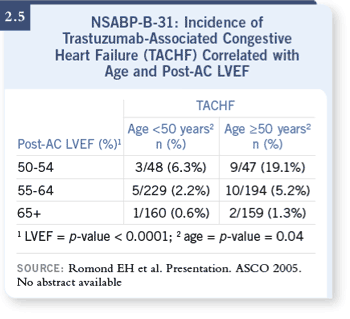 During treatment with
trastuzumab, patients
underwent a MUGA scan
every three months. During
the year of treatment, 20
percent of patients had to
stop trastuzumab because
of an asymptomatic drop
in left ventricular ejection
fraction or because of developing
symptomatic problems
(Romond 2005a). During treatment with
trastuzumab, patients
underwent a MUGA scan
every three months. During
the year of treatment, 20
percent of patients had to
stop trastuzumab because
of an asymptomatic drop
in left ventricular ejection
fraction or because of developing
symptomatic problems
(Romond 2005a).
The predictors of developing
symptomatic problems were
age and a relatively low
ejection fraction. For patients
who were older than 50 years of age and had a left ventricular ejection fraction
after the AC times four that was between 50 and 54 percent, their risk of
developing congestive heart failure was 20 percent.
Conversely, for the patients who were younger than 50 years of age and had
left ventricular ejection fractions of greater than 65 percent after the AC times
four, their risk of congestive heart failure during therapy was 0.6 percent.
It’s clear that there are at-risk populations that need to be identified and
monitored during such treatment (Romond 2005; [2.5]).
 Track 10 Track 10
 DR LOVE: Would you comment on the study that was done in Canada to
validate the Adjuvant! Online model? DR LOVE: Would you comment on the study that was done in Canada to
validate the Adjuvant! Online model? |
 DR RAVDIN: Adjuvant! Online is an evidence-based model, but there are a
few studies that have been done to validate it. One of them utilized the excellent
population-based database in British Columbia (Olivotto 2005). They
have very good records across the province, capturing most of the breast
cancer cases and detailed information about them. They sent us the actual
patient and tumor descriptions. Based on that information, we generated
projections of 10-year survivals for those patients. DR RAVDIN: Adjuvant! Online is an evidence-based model, but there are a
few studies that have been done to validate it. One of them utilized the excellent
population-based database in British Columbia (Olivotto 2005). They
have very good records across the province, capturing most of the breast
cancer cases and detailed information about them. They sent us the actual
patient and tumor descriptions. Based on that information, we generated
projections of 10-year survivals for those patients.
We put 4,000 cases into the model. The results of our projections were then
sent back to British Columbia, and they matched them with the outcomes.
We were very close to the actual numbers, on average, within about one
percent (2.6).
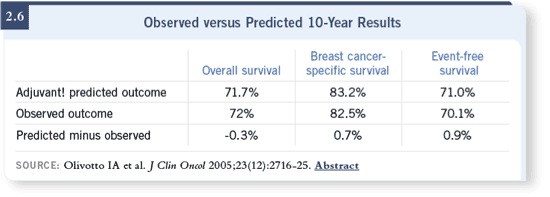
One of the areas of inaccuracy was in patients less than 35 years of age, where
we debated about whether or not, based on the literature and some of our
own analyses, to assign those patients a little bit worse prognosis. The British
Columbia analysis would suggest that we should have (Olivotto 2005).
Our analysis overall was strongest for breast cancer-specific mortality. Relapse
was very strong, but not as strong as mortality. I still feel that mortality is the
best endpoint for the model. They felt the model was well validated across all
the different subsets and endpoints. It was presented last year at ASCO, and on
April 20th, it was published in the Journal of Clinical Oncology (Olivotto 2005).
 Track 12 Track 12
 DR LOVE: Let’s talk about adjuvant endocrine therapy. Do you think
there’s any justification for utilizing five years of adjuvant tamoxifen at
this point in postmenopausal women? DR LOVE: Let’s talk about adjuvant endocrine therapy. Do you think
there’s any justification for utilizing five years of adjuvant tamoxifen at
this point in postmenopausal women? |
 DR RAVDIN: I believe very few people are being started on tamoxifen with
the intention of receiving five years of tamoxifen and then switching to an
aromatase inhibitor. The problem with initially starting on tamoxifen is that
strategies that originally start with an aromatase inhibitor will have lower
recurrence rates than those starting with tamoxifen. DR RAVDIN: I believe very few people are being started on tamoxifen with
the intention of receiving five years of tamoxifen and then switching to an
aromatase inhibitor. The problem with initially starting on tamoxifen is that
strategies that originally start with an aromatase inhibitor will have lower
recurrence rates than those starting with tamoxifen.
For instance, if you start a patient on tamoxifen, you’re conceding that she is
going to do worse than she would have done on an aromatase inhibitor. Then
you have to feel that when you switch her, the curves will then recross.
In other words, the aromatase inhibitor will be so much more effective if
delivered later that it will catch up and overtake the group that did not receive
the aromatase inhibitor from the beginning. That is possible, theoretically,
because tamoxifen and the aromatase inhibitors — since they have somewhat
different mechanisms of action — will actually be somewhat noncross resistant.
Therefore, a strategy that employs both agents might provide the most benefit.
But that’s a theoretical consideration against the very real fact that we know if
you start with an aromatase inhibitor, the patients do better.
 DR LOVE: Our CME group did a patterns of care study looking at whether
physicians switch postmenopausal women to an aromatase inhibitor after two
to three years of tamoxifen. A surprising number of community oncologists
continue tamoxifen for five years, whereas breast cancer clinical investigators
tend to switch to an aromatase inhibitor after two to three years of tamoxifen.
Who’s right? DR LOVE: Our CME group did a patterns of care study looking at whether
physicians switch postmenopausal women to an aromatase inhibitor after two
to three years of tamoxifen. A surprising number of community oncologists
continue tamoxifen for five years, whereas breast cancer clinical investigators
tend to switch to an aromatase inhibitor after two to three years of tamoxifen.
Who’s right?
 DR RAVDIN: At this point, it’s not clear who’s right, because it’s not clear
which strategy is really better. My money is on the idea that switching is
the right thing to do, because we know that the patients whose therapy is
switched at two to three years are doing better than the patients who continue
on tamoxifen for five years. DR RAVDIN: At this point, it’s not clear who’s right, because it’s not clear
which strategy is really better. My money is on the idea that switching is
the right thing to do, because we know that the patients whose therapy is
switched at two to three years are doing better than the patients who continue
on tamoxifen for five years.
I believe much of the benefit of adjuvant tamoxifen actually occurs in the first
two years. There’s a little bit of additional benefit for continuing it out to five
years. Continuing it beyond that doesn’t apparently provide any additional
benefit, at least in NSABP-B-14 (Fisher 2001).
So with time, the benefit of tamoxifen attenuates. If you’re switching at two
to three years, what you’re doing is you’re switching away from a drug that’s
beginning to be less and less effective. And it looks like you’re obtaining a
very effective impact from the aromatase inhibitor administered at that point.
 DR LOVE: In the patient who’s going to switch from tamoxifen during
the first five years of therapy, how long are you going to use the aromatase
inhibitor? DR LOVE: In the patient who’s going to switch from tamoxifen during
the first five years of therapy, how long are you going to use the aromatase
inhibitor?
 DR RAVDIN: The clinical trial data we have right now use two to three years
of an aromatase inhibitor after tamoxifen. There are some trials extending
aromatase inhibitor therapy out beyond five years of therapy. MA17 is looking
to see whether or not there might be additional benefit. My guess is there
will be additional benefit because the aromatase inhibitors, I believe, are not
agonists-antagonists like tamoxifen. DR RAVDIN: The clinical trial data we have right now use two to three years
of an aromatase inhibitor after tamoxifen. There are some trials extending
aromatase inhibitor therapy out beyond five years of therapy. MA17 is looking
to see whether or not there might be additional benefit. My guess is there
will be additional benefit because the aromatase inhibitors, I believe, are not
agonists-antagonists like tamoxifen.
Tamoxifen can be reinterpreted by cells, after molecular changes, to be a
stimulant, whereas I can’t see how the absence of estrogen could ever be reinterpreted
as a stimulant. I would suspect the aromatase inhibitors would be
harder to develop resistance to and therefore might be superior in the adjuvant
hormonal therapy of breast cancer.
 DR LOVE: What about the patient who’s been on tamoxifen for six months,
one year or one and a half years? Do you wait until she is at the two-year or
three-year point to switch her therapy? DR LOVE: What about the patient who’s been on tamoxifen for six months,
one year or one and a half years? Do you wait until she is at the two-year or
three-year point to switch her therapy?
 DR RAVDIN: Actually, I wait. At this point I have no patients who have just
started tamoxifen. For those patients who have been on tamoxifen for a year, I
wait until the two- to three-year point before switching. DR RAVDIN: Actually, I wait. At this point I have no patients who have just
started tamoxifen. For those patients who have been on tamoxifen for a year, I
wait until the two- to three-year point before switching.
 Track 14 Track 14
 DR LOVE: What about hormonal therapy in the premenopausal patient
with an ER-positive tumor? There are a number of major international
trials looking at this (2.7). How do you approach it right now in a clinical
setting? The question a lot of people have is in regard to the patient with
many positive nodes or the patient with many positive nodes and an ER-positive,
HER2-positive tumor. DR LOVE: What about hormonal therapy in the premenopausal patient
with an ER-positive tumor? There are a number of major international
trials looking at this (2.7). How do you approach it right now in a clinical
setting? The question a lot of people have is in regard to the patient with
many positive nodes or the patient with many positive nodes and an ER-positive,
HER2-positive tumor. |
 DR RAVDIN: The data, of course, are insufficient to decide or we wouldn’t be
conducting these trials. Nonetheless, off study, particularly in patients less than
35 years of age, looking at the trial data, it’s apparent that combined hormonal
therapy looks like it’s better than single-modality hormonal therapy. Specifically,
the kind of combined therapy that’s been looked at up until this point in
that scenario is ovarian suppression with an LHRH analog plus tamoxifen. DR RAVDIN: The data, of course, are insufficient to decide or we wouldn’t be
conducting these trials. Nonetheless, off study, particularly in patients less than
35 years of age, looking at the trial data, it’s apparent that combined hormonal
therapy looks like it’s better than single-modality hormonal therapy. Specifically,
the kind of combined therapy that’s been looked at up until this point in
that scenario is ovarian suppression with an LHRH analog plus tamoxifen.
I actually like that strategy more than the strategy of using such ovarian
suppression plus an aromatase inhibitor. The reason why I like that strategy
better is because tamoxifen is blocking the estrogen receptor and you’re
lowering the estrogen level.
If you’re using both ovarian suppression and also the aromatase inhibitor,
you’re using two things to reduce estrogen, and you’re not really attacking
two different parts of the chain. Whether that is the right way to think will
be, I believe, demonstrated by the ongoing trials, which are comparing the
two strategies.
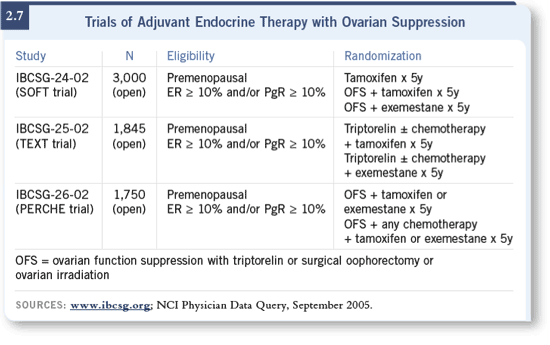
 Track 17 Track 17
 DR LOVE: The 2000 overview (EBCTCG 2005) was published recently.
Is there anything in this publication that you think is important for clinicians
in practice to know about? DR LOVE: The 2000 overview (EBCTCG 2005) was published recently.
Is there anything in this publication that you think is important for clinicians
in practice to know about? |
 DR RAVDIN: Actually, there’s nothing in it that I believe is strikingly different
from the overview that was published in 1998. I believe what is important
about the overview is it shows that we’re not delaying recurrence and death,
but rather adjuvant therapy seems to be preventing it. DR RAVDIN: Actually, there’s nothing in it that I believe is strikingly different
from the overview that was published in 1998. I believe what is important
about the overview is it shows that we’re not delaying recurrence and death,
but rather adjuvant therapy seems to be preventing it.
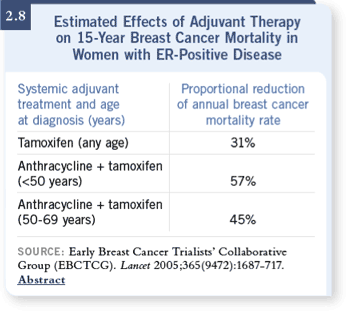 In other words, the relapse-free survival and the overall survival advantages
that accrue early in the patients’ clinical course actually are maintained out
to 15 years (EBCTCG 2005). That is really good news, because there don’t
appear to be late toxicities eroding those advantages. I believe that’s one thing
the overview says that’s
powerfully important.
In other words, the relapse-free survival and the overall survival advantages
that accrue early in the patients’ clinical course actually are maintained out
to 15 years (EBCTCG 2005). That is really good news, because there don’t
appear to be late toxicities eroding those advantages. I believe that’s one thing
the overview says that’s
powerfully important.
There are a lot of data
in the overview about
anthracyclines and some
of the anthracycline-based
regimens. What made the
headlines is if you use a good
chemotherapy regimen plus a
good hormonal regimen, you
reduce your risk of mortality
by about 50 percent (2.8). So
that’s something we all knew,
but the publication caused a
special notice.
Select publications
|

